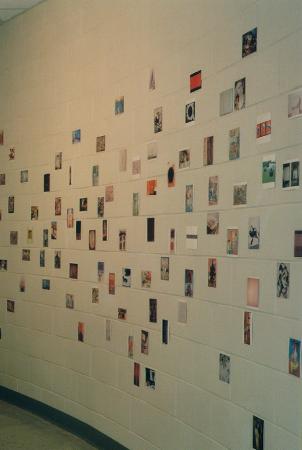| |
Klein
and Judo - Julian Haladyn
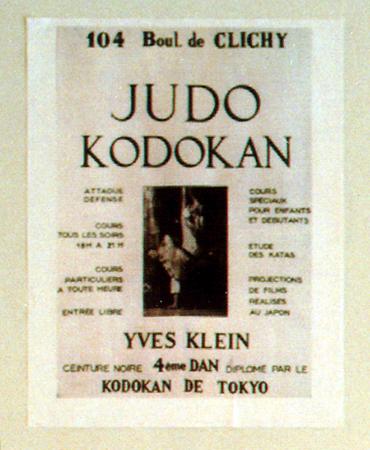 Klein
began studying judo in September, 1947, while living in Nice. Although
he was not originally gifted in the art, Klein's obsessive persistence
would allow him not only to excel, but eventually to achieve a fourth dan
black belt from the acclaimed Kodokan school in Tokyo, on December 14,
1953, at the age of twenty-five. The importance judo played in Klein's
artistic and social development was extreme; "The self-discipline of judo
structured his personality, and gave him, along with mastery of himself,
the faculties of concentration, impregnation, and recovery on which his
whole method of sensitivity rests." (15 Restany) These faculties which
Klein learnt through his studies in judo where to be the foundation of
his artistic practices, on which he would develop his philosophy of life. Klein
began studying judo in September, 1947, while living in Nice. Although
he was not originally gifted in the art, Klein's obsessive persistence
would allow him not only to excel, but eventually to achieve a fourth dan
black belt from the acclaimed Kodokan school in Tokyo, on December 14,
1953, at the age of twenty-five. The importance judo played in Klein's
artistic and social development was extreme; "The self-discipline of judo
structured his personality, and gave him, along with mastery of himself,
the faculties of concentration, impregnation, and recovery on which his
whole method of sensitivity rests." (15 Restany) These faculties which
Klein learnt through his studies in judo where to be the foundation of
his artistic practices, on which he would develop his philosophy of life.
The main tenet of judo is
"to make the most efficient use of mental and physical energy." (16 Kano)
This is taught in judo using two basic methods: Kala and Randori. Kala,
which means "form", is a system of prearranged movements which the student
learns and preforms in front of teachers and other students; these movements
are meant to teach the student the foundations of attack and defence. Randori,
which means "free practice", is a time to practice the techniques which
the student has learnt, where students are paired off and spar with each
other, as would happen in a real judo match or confrontation. "The objective
of this systematic physical training is to perfect control over the mind
and body and to prepare a person to meet any emergency or attack, accidental
or intentional." (22 Kano) These same two methods can be seen in Klein's
artistic process, with kata being related to ritual and randori being related
to performance.
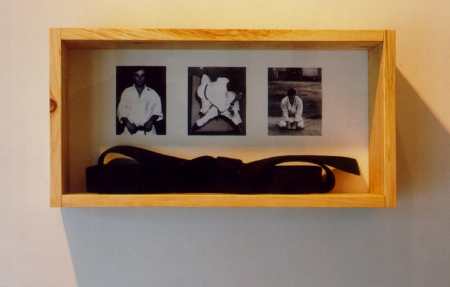 The
rituals associated with Klein's works - such as the ingesting of the blue
cocktail before entering Le Vide or the bunting of the receipts after the
purchase of that void - are meant to teach the 'reader" of his works the
language he is using to express his vast ideas, preparing them for, or
inaugurating them into, the experience wlnch Klein has arranged for them.
As in the kata, these rituals strengthen the mind's ability to adapt and
respond to unknown stimuli through the continual repetition of certain
key elements; once these elements have been presented enough they become
second nature, one no longer has to "think" about them to be aware of them.
Klein's ritualistic use of the I.K.B. serves this fluiction, where after
seeing enough blue monochromes one no longer "thinks" of the blue, this
allows the mind to ftrrther investigate what is being presented. And what
is left once one takes away the external blue of the monochromes, or for
that matter the walls of Le Vide? What the viewer is left with is themselves.
In the case of leVide the ritual performed before entering the void room
makes one more open to experience the unexpected lack of external stimulation
as a potential rather than a drawback. The potential I believe Klein presented
was simply the possibility of experiencing ourselves in a new way. By giving
nothing external to relate to, he is asking us to project ourselves upon
the whiteness of the walls, much like a movie is projected upon a white
screen. After the kata has been practiced, giving the student the tools
with which to attack and defend, then the student begins randori. The
rituals associated with Klein's works - such as the ingesting of the blue
cocktail before entering Le Vide or the bunting of the receipts after the
purchase of that void - are meant to teach the 'reader" of his works the
language he is using to express his vast ideas, preparing them for, or
inaugurating them into, the experience wlnch Klein has arranged for them.
As in the kata, these rituals strengthen the mind's ability to adapt and
respond to unknown stimuli through the continual repetition of certain
key elements; once these elements have been presented enough they become
second nature, one no longer has to "think" about them to be aware of them.
Klein's ritualistic use of the I.K.B. serves this fluiction, where after
seeing enough blue monochromes one no longer "thinks" of the blue, this
allows the mind to ftrrther investigate what is being presented. And what
is left once one takes away the external blue of the monochromes, or for
that matter the walls of Le Vide? What the viewer is left with is themselves.
In the case of leVide the ritual performed before entering the void room
makes one more open to experience the unexpected lack of external stimulation
as a potential rather than a drawback. The potential I believe Klein presented
was simply the possibility of experiencing ourselves in a new way. By giving
nothing external to relate to, he is asking us to project ourselves upon
the whiteness of the walls, much like a movie is projected upon a white
screen. After the kata has been practiced, giving the student the tools
with which to attack and defend, then the student begins randori.
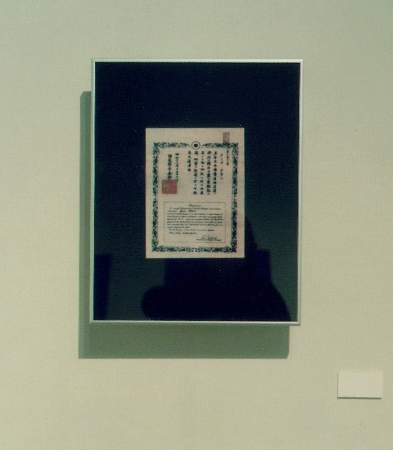 Klein's
performances are his "free practice", where he is able to try out his ideas
on a Klein's
performances are his "free practice", where he is able to try out his ideas
on a
willing audience. It is
of little importance whether or not the viewer likes or dislikes the work
they experience, Klein's main concern is that they open themselves up to
the potentials inherent in what he is presenting. All of Klein's work is
"aimed at expanding and intensitying human awareness of the actualities
of existence. Above all, he wanted to awaken an individual's sensibility
- one's capacity to see, feel, and think - especially as this might enrich
one's experience of the most fundainental, primal elements that are the
nourishing agents of life and the universe." (7 Stich) Unlike in the paintings
of Malevich, with whom Klein has often been compared, there is no symbolic
meaning inherent in his use of blue which the viewer is suppose to interpret
in order to uncover the "true" meaning of the work. As Klein himself states:
"The object of art is not the painting (i.e., another object), but life
(i.e., a universal principle)." (7 Restany) lii this way the work of art
becomes merely a reference point from which to begin experiencing, and
not the end in itself. What Klein continually shows in his work are traces
of real experience, his pre-arranged kata's, and the viewer is then able,
once the work has been made public, to interact or spar with it. One work
which particularly addresses this is the Anthropometrv performance, where
"traces" of reality are literally printed on the canvas using the real
object - as opposed to the traditional method which produces a simulacra
of the object using fabricated utensils, which have little or no relation
to the object being depicted. Klein said:
"the time of the
brush had ended and finally my knowledge ofjudo was gomg to be useful.
My models were my brushes. I had them smear themselves with colour and
imprint themselves on the canvas.. But this was only the first step. I
thereafter devised a sort of ballet of girls smeared on a grand canvas
which resembled the white mat ofjudo contests." (171-2 Stich)
This explicit reference made
to randori illustrates the impact it had upon Klein's sensibility.
The simplicity of means used
by Klein to express his ideas leads back to the niain tenet of judo, using
both mental and physical energy enough, but not too much, to accomplish
what is needed From judo Klein learned to look for the most direct course
of action, to consider carefully, and then act decisively and without hesitation.
And it is this philosophy that I believe formed the foundations of Klein's
artistic productions.
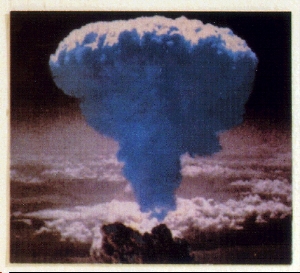 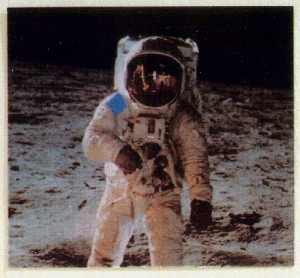
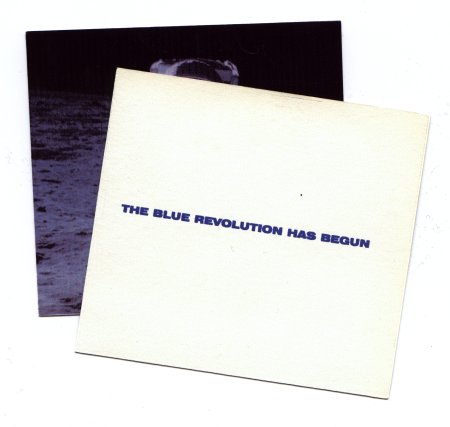
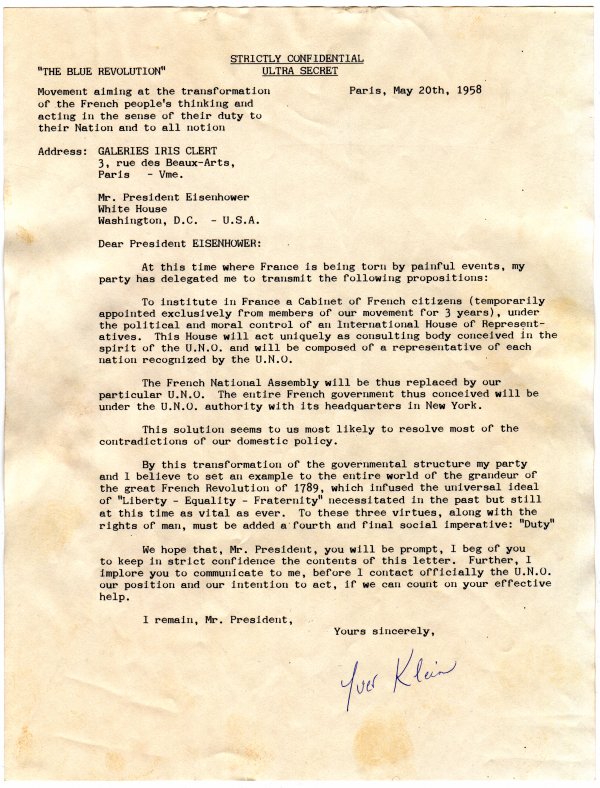
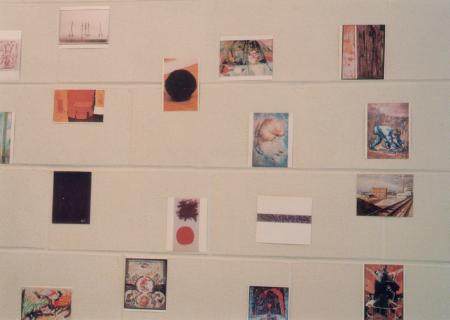
|
|
 Klein
began studying judo in September, 1947, while living in Nice. Although
he was not originally gifted in the art, Klein's obsessive persistence
would allow him not only to excel, but eventually to achieve a fourth dan
black belt from the acclaimed Kodokan school in Tokyo, on December 14,
1953, at the age of twenty-five. The importance judo played in Klein's
artistic and social development was extreme; "The self-discipline of judo
structured his personality, and gave him, along with mastery of himself,
the faculties of concentration, impregnation, and recovery on which his
whole method of sensitivity rests." (15 Restany) These faculties which
Klein learnt through his studies in judo where to be the foundation of
his artistic practices, on which he would develop his philosophy of life.
Klein
began studying judo in September, 1947, while living in Nice. Although
he was not originally gifted in the art, Klein's obsessive persistence
would allow him not only to excel, but eventually to achieve a fourth dan
black belt from the acclaimed Kodokan school in Tokyo, on December 14,
1953, at the age of twenty-five. The importance judo played in Klein's
artistic and social development was extreme; "The self-discipline of judo
structured his personality, and gave him, along with mastery of himself,
the faculties of concentration, impregnation, and recovery on which his
whole method of sensitivity rests." (15 Restany) These faculties which
Klein learnt through his studies in judo where to be the foundation of
his artistic practices, on which he would develop his philosophy of life.


 The
rituals associated with Klein's works - such as the ingesting of the blue
cocktail before entering Le Vide or the bunting of the receipts after the
purchase of that void - are meant to teach the 'reader" of his works the
language he is using to express his vast ideas, preparing them for, or
inaugurating them into, the experience wlnch Klein has arranged for them.
As in the kata, these rituals strengthen the mind's ability to adapt and
respond to unknown stimuli through the continual repetition of certain
key elements; once these elements have been presented enough they become
second nature, one no longer has to "think" about them to be aware of them.
Klein's ritualistic use of the I.K.B. serves this fluiction, where after
seeing enough blue monochromes one no longer "thinks" of the blue, this
allows the mind to ftrrther investigate what is being presented. And what
is left once one takes away the external blue of the monochromes, or for
that matter the walls of Le Vide? What the viewer is left with is themselves.
In the case of leVide the ritual performed before entering the void room
makes one more open to experience the unexpected lack of external stimulation
as a potential rather than a drawback. The potential I believe Klein presented
was simply the possibility of experiencing ourselves in a new way. By giving
nothing external to relate to, he is asking us to project ourselves upon
the whiteness of the walls, much like a movie is projected upon a white
screen. After the kata has been practiced, giving the student the tools
with which to attack and defend, then the student begins randori.
The
rituals associated with Klein's works - such as the ingesting of the blue
cocktail before entering Le Vide or the bunting of the receipts after the
purchase of that void - are meant to teach the 'reader" of his works the
language he is using to express his vast ideas, preparing them for, or
inaugurating them into, the experience wlnch Klein has arranged for them.
As in the kata, these rituals strengthen the mind's ability to adapt and
respond to unknown stimuli through the continual repetition of certain
key elements; once these elements have been presented enough they become
second nature, one no longer has to "think" about them to be aware of them.
Klein's ritualistic use of the I.K.B. serves this fluiction, where after
seeing enough blue monochromes one no longer "thinks" of the blue, this
allows the mind to ftrrther investigate what is being presented. And what
is left once one takes away the external blue of the monochromes, or for
that matter the walls of Le Vide? What the viewer is left with is themselves.
In the case of leVide the ritual performed before entering the void room
makes one more open to experience the unexpected lack of external stimulation
as a potential rather than a drawback. The potential I believe Klein presented
was simply the possibility of experiencing ourselves in a new way. By giving
nothing external to relate to, he is asking us to project ourselves upon
the whiteness of the walls, much like a movie is projected upon a white
screen. After the kata has been practiced, giving the student the tools
with which to attack and defend, then the student begins randori.
 Klein's
performances are his "free practice", where he is able to try out his ideas
on a
Klein's
performances are his "free practice", where he is able to try out his ideas
on a



